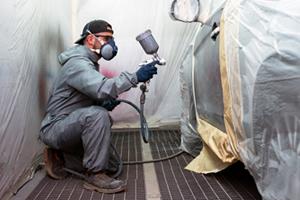Fixed ladder safety checklist
A fixed ladder is a ladder permanently attached to a structure, building or equipment. Fixed ladders will normally be of a length greater than 20 ft. (6.1 m) to a maximum unbroken length of 30 ft. (9.1 m), and be equipped with cages or ladder safety devices. A “cage” is a guard that is fastened to the side rails of the fixed ladder, or to the structure, to encircle the climbing space of the ladder for the safety of the person climbing the ladder.
The primary hazard when using a ladder is falling. A poorly designed, maintained or improperly used ladder may collapse under the load placed upon it and result in a fall.
The following checklist can be used to evaluate the safety of fixed ladders:
- Is the fixed ladder routinely cleaned and serviced?
- Are rungs kept free of grease, mud, or other slippery agents?
- Are metal ladders painted or treated to prevent corrosion or rust?
- For a ladder over 20 ft., is a cage or other safety device attached?
- If a cage is installed, does it extend a minimum of 42 in.above the top of a landing?
- If a cage is installed, does it extend down the ladder to a point not less than 7 ft., or more than 8 ft., above the base of the ladder and allow for easy access and egress?
- If a personal fall protection system is used, does it permit the user to ascend or descend without having to hold, pull, or push any part of the safety device, leaving both hands free for climbing?
- Are all climbing safety devices inspected prior to using a ladder?
- Does the ladder have a landing platform that serves as a means of resting place during long climbs?
- If the ladder is used to ascend to heights exceeding 20 ft., is it constructed with landing platforms for each 30 ft. of height or fraction thereof?
- Is the pitch of the ladder in the range of 75 to 90 degrees with the horizontal?
- Are ladders having a pitch in excess of 90 degrees with the horizontal, prohibited from use?
- Do the rungs on metal ladders have a minimum diameter of three-fourths in.?
- Is the distance between rungs 12 in. or less and uniform throughout the length of the ladder?
- Are ladders inspected periodically for damage, defects or corrosion?
Employers should establish and implement adequate controls, such as barricades and signs, to prevent non-emergency use of fixed ladders which are meant for fire fighter use and emergency escape only. In some situations, fixed ladders not equipped with cages, landing platforms, ladder safety devices, or other forms of worker protection, may be allowed as a means of access for fire fighters and other emergency personnel, or escape for workers in fire and other emergency situations.
Copyright ©2008, Services Properties, Inc.
This material is provided for informational purposes only and does not provide any coverage or guarantee loss prevention. The examples in this material are provided as hypothetical and for illustration purposes only. The Hanover Insurance Company and its affiliates and subsidiaries (“The Hanover”) specifically disclaim any warranty or representation that acceptance of any recommendations contained herein will make any premises, or operation safe or in compliance with any law or regulation. By providing this information to you, The Hanover does not assume (and specifically disclaims) any duty, undertaking or responsibility to you. The decision to accept or implement any recommendation(s) or advice contained in this material must be made by you.
LC MAR 2019-198
171-0991 (3/14)
Related resources
Fixed ladder safety checklist
A fixed ladder is a ladder permanently attached to a structure, building or equipment. Fixed ladders will normally be of a length greater than 20 ft. (6.1 m) to a maximum unbroken length of 30 ft. (9.1 m), and be equipped with cages or ladder safety devices. A “cage” is a guard that is fastened to the side rails of the fixed ladder, or to the structure, to encircle the climbing space of the ladder for the safety of the person climbing the ladder.
The primary hazard when using a ladder is falling. A poorly designed, maintained or improperly used ladder may collapse under the load placed upon it and result in a fall.
The following checklist can be used to evaluate the safety of fixed ladders:
- Is the fixed ladder routinely cleaned and serviced?
- Are rungs kept free of grease, mud, or other slippery agents?
- Are metal ladders painted or treated to prevent corrosion or rust?
- For a ladder over 20 ft., is a cage or other safety device attached?
- If a cage is installed, does it extend a minimum of 42 in.above the top of a landing?
- If a cage is installed, does it extend down the ladder to a point not less than 7 ft., or more than 8 ft., above the base of the ladder and allow for easy access and egress?
- If a personal fall protection system is used, does it permit the user to ascend or descend without having to hold, pull, or push any part of the safety device, leaving both hands free for climbing?
- Are all climbing safety devices inspected prior to using a ladder?
- Does the ladder have a landing platform that serves as a means of resting place during long climbs?
- If the ladder is used to ascend to heights exceeding 20 ft., is it constructed with landing platforms for each 30 ft. of height or fraction thereof?
- Is the pitch of the ladder in the range of 75 to 90 degrees with the horizontal?
- Are ladders having a pitch in excess of 90 degrees with the horizontal, prohibited from use?
- Do the rungs on metal ladders have a minimum diameter of three-fourths in.?
- Is the distance between rungs 12 in. or less and uniform throughout the length of the ladder?
- Are ladders inspected periodically for damage, defects or corrosion?
Employers should establish and implement adequate controls, such as barricades and signs, to prevent non-emergency use of fixed ladders which are meant for fire fighter use and emergency escape only. In some situations, fixed ladders not equipped with cages, landing platforms, ladder safety devices, or other forms of worker protection, may be allowed as a means of access for fire fighters and other emergency personnel, or escape for workers in fire and other emergency situations.
Copyright ©2008, Services Properties, Inc.
This material is provided for informational purposes only and does not provide any coverage or guarantee loss prevention. The examples in this material are provided as hypothetical and for illustration purposes only. The Hanover Insurance Company and its affiliates and subsidiaries (“The Hanover”) specifically disclaim any warranty or representation that acceptance of any recommendations contained herein will make any premises, or operation safe or in compliance with any law or regulation. By providing this information to you, The Hanover does not assume (and specifically disclaims) any duty, undertaking or responsibility to you. The decision to accept or implement any recommendation(s) or advice contained in this material must be made by you.
LC MAR 2019-198
171-0991 (3/14)
Related resources
Fixed ladder safety checklist
A fixed ladder is a ladder permanently attached to a structure, building or equipment. Fixed ladders will normally be of a length greater than 20 ft. (6.1 m) to a maximum unbroken length of 30 ft. (9.1 m), and be equipped with cages or ladder safety devices. A “cage” is a guard that is fastened to the side rails of the fixed ladder, or to the structure, to encircle the climbing space of the ladder for the safety of the person climbing the ladder.
The primary hazard when using a ladder is falling. A poorly designed, maintained or improperly used ladder may collapse under the load placed upon it and result in a fall.
The following checklist can be used to evaluate the safety of fixed ladders:
- Is the fixed ladder routinely cleaned and serviced?
- Are rungs kept free of grease, mud, or other slippery agents?
- Are metal ladders painted or treated to prevent corrosion or rust?
- For a ladder over 20 ft., is a cage or other safety device attached?
- If a cage is installed, does it extend a minimum of 42 in.above the top of a landing?
- If a cage is installed, does it extend down the ladder to a point not less than 7 ft., or more than 8 ft., above the base of the ladder and allow for easy access and egress?
- If a personal fall protection system is used, does it permit the user to ascend or descend without having to hold, pull, or push any part of the safety device, leaving both hands free for climbing?
- Are all climbing safety devices inspected prior to using a ladder?
- Does the ladder have a landing platform that serves as a means of resting place during long climbs?
- If the ladder is used to ascend to heights exceeding 20 ft., is it constructed with landing platforms for each 30 ft. of height or fraction thereof?
- Is the pitch of the ladder in the range of 75 to 90 degrees with the horizontal?
- Are ladders having a pitch in excess of 90 degrees with the horizontal, prohibited from use?
- Do the rungs on metal ladders have a minimum diameter of three-fourths in.?
- Is the distance between rungs 12 in. or less and uniform throughout the length of the ladder?
- Are ladders inspected periodically for damage, defects or corrosion?
Employers should establish and implement adequate controls, such as barricades and signs, to prevent non-emergency use of fixed ladders which are meant for fire fighter use and emergency escape only. In some situations, fixed ladders not equipped with cages, landing platforms, ladder safety devices, or other forms of worker protection, may be allowed as a means of access for fire fighters and other emergency personnel, or escape for workers in fire and other emergency situations.
Copyright ©2008, Services Properties, Inc.
This material is provided for informational purposes only and does not provide any coverage or guarantee loss prevention. The examples in this material are provided as hypothetical and for illustration purposes only. The Hanover Insurance Company and its affiliates and subsidiaries (“The Hanover”) specifically disclaim any warranty or representation that acceptance of any recommendations contained herein will make any premises, or operation safe or in compliance with any law or regulation. By providing this information to you, The Hanover does not assume (and specifically disclaims) any duty, undertaking or responsibility to you. The decision to accept or implement any recommendation(s) or advice contained in this material must be made by you.
LC MAR 2019-198
171-0991 (3/14)
Related resources
Fixed ladder safety checklist
A fixed ladder is a ladder permanently attached to a structure, building or equipment. Fixed ladders will normally be of a length greater than 20 ft. (6.1 m) to a maximum unbroken length of 30 ft. (9.1 m), and be equipped with cages or ladder safety devices. A “cage” is a guard that is fastened to the side rails of the fixed ladder, or to the structure, to encircle the climbing space of the ladder for the safety of the person climbing the ladder.
The primary hazard when using a ladder is falling. A poorly designed, maintained or improperly used ladder may collapse under the load placed upon it and result in a fall.
The following checklist can be used to evaluate the safety of fixed ladders:
- Is the fixed ladder routinely cleaned and serviced?
- Are rungs kept free of grease, mud, or other slippery agents?
- Are metal ladders painted or treated to prevent corrosion or rust?
- For a ladder over 20 ft., is a cage or other safety device attached?
- If a cage is installed, does it extend a minimum of 42 in.above the top of a landing?
- If a cage is installed, does it extend down the ladder to a point not less than 7 ft., or more than 8 ft., above the base of the ladder and allow for easy access and egress?
- If a personal fall protection system is used, does it permit the user to ascend or descend without having to hold, pull, or push any part of the safety device, leaving both hands free for climbing?
- Are all climbing safety devices inspected prior to using a ladder?
- Does the ladder have a landing platform that serves as a means of resting place during long climbs?
- If the ladder is used to ascend to heights exceeding 20 ft., is it constructed with landing platforms for each 30 ft. of height or fraction thereof?
- Is the pitch of the ladder in the range of 75 to 90 degrees with the horizontal?
- Are ladders having a pitch in excess of 90 degrees with the horizontal, prohibited from use?
- Do the rungs on metal ladders have a minimum diameter of three-fourths in.?
- Is the distance between rungs 12 in. or less and uniform throughout the length of the ladder?
- Are ladders inspected periodically for damage, defects or corrosion?
Employers should establish and implement adequate controls, such as barricades and signs, to prevent non-emergency use of fixed ladders which are meant for fire fighter use and emergency escape only. In some situations, fixed ladders not equipped with cages, landing platforms, ladder safety devices, or other forms of worker protection, may be allowed as a means of access for fire fighters and other emergency personnel, or escape for workers in fire and other emergency situations.
Copyright ©2008, Services Properties, Inc.
This material is provided for informational purposes only and does not provide any coverage or guarantee loss prevention. The examples in this material are provided as hypothetical and for illustration purposes only. The Hanover Insurance Company and its affiliates and subsidiaries (“The Hanover”) specifically disclaim any warranty or representation that acceptance of any recommendations contained herein will make any premises, or operation safe or in compliance with any law or regulation. By providing this information to you, The Hanover does not assume (and specifically disclaims) any duty, undertaking or responsibility to you. The decision to accept or implement any recommendation(s) or advice contained in this material must be made by you.
LC MAR 2019-198
171-0991 (3/14)





